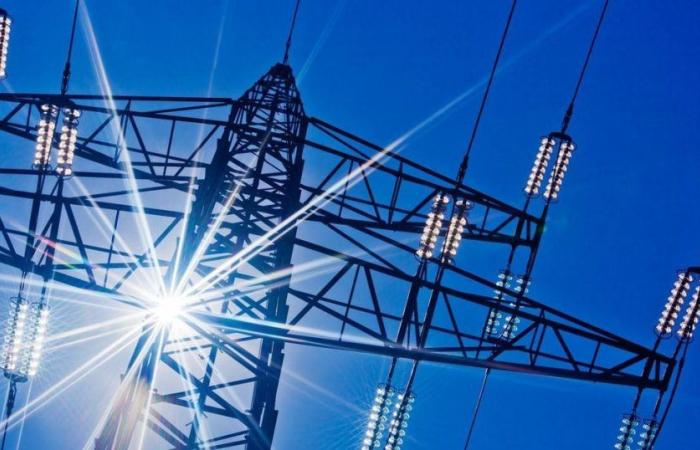More than 571 million Africans do not have access to electricity, despite the efforts made in recent years by several countries on the continent and the numerous potential that the continent has to produce electricity like oil. , gas, coal, hydroelectricity, not to mention the exceptional potential offered by renewable energies: solar, wind and geothermal energy.
Due to demographic growth faster than energy investments, the number of people without access to electricity has increased in recent years, from 566 million in 2010 to 571 million in 2022.
Lagos (Nigeria): Africa’s leading economic and demographic power with a population of more than 230 million inhabitants, Nigeria has an electrification rate of 60%. It is the country with the most people without access to electricity (86 million) in the world. Shutterstock
The latest report published by the International Energy Agency (IEA), in collaboration with the World Bank and other institutions, is edifying. It clearly emerges that of the 20 least electrified countries in the world, 18 are in sub-Saharan Africa. This region of the continent alone accounts for 83% of people without access to electricity in the world, compared to 50% in 2020.
According to this report, “by 2022, the 20 countries identified as having the highest number of people living without electricity accounted for almost 75% of the global electricity access deficit. Eighteen of these countries are in sub-Saharan Africa and 17 are among the most underserved countries. Worse still, the three countries with the largest number of people without access to electricity in the world are Nigeria (86.2 million people), the DRC (77.7 million) and Ethiopia (55 million). Countries that are among the economic and demographic powers of the continent.
Read also: Africa’s energy independence: why nuclear power is not the right solution
Nigeria, although until recently considered the leading economic power on the continent, has a low electrification rate of around 60%. However, if this country is the most populous in Africa with more than 220 million inhabitants, it is also the continent’s leading oil producer and has the largest gas reserves in Africa. This means that the country does not lack natural resources to produce electricity. The deficit can mainly be explained by inadequate economic policies.
The same goes for the Democratic Republic of Congo (DRC), which has significant mining resources and, above all, one of the largest hydroelectric potentials in the world with the Congo River, but which has a very low electrification rate (21%). A situation which greatly hampers the economic development of the country.
For Ethiopia, which has one of the highest growth rates in terms of electrification, the situation should evolve positively in the years to come with the major hydroelectric dams currently under construction, including the Grand Ethiopian Renaissance Dam. with a capacity of 6450 MW. The country currently has an electrification rate of 55%, with electricity produced from renewable resources, particularly hydroelectric sources.
Read also: Energy: mini-grids as a solution to Africa’s low electrification
The other contrast comes from South Sudan which has the lowest electrification rate in the world, only 5%, even though it is an oil producer and exporter. In this case, political instability with the internal wars waged by the regime’s leaders prevents investment and the development of the country’s energy infrastructure.
South Sudan and Nigeria are not the only oil-producing countries on the continent to have such low electrification rates compared to their potential. This is also the case for Chad (12%), but also for Angola, Africa’s second largest oil producer, which has an electrification rate of only 48%.
Only two non-African countries are among the 20 least electrified countries in the world: Burma (18th) and Pakistan (20th)
The 18 African countries among the 20 countries in the world with the lowest electrification rates
| World rank | Country | Electrification rate |
|---|---|---|
| 1st | South Sudan | 5% |
| 2nd | Burundi | 10% |
| 3rd | Chad | 12% |
| 4th | Malawi | 14% |
| 5th | Burkina Faso | 19% |
| 6th | Niger | 20% |
| 7th | Democratic Republic of Congo (DRC) | 21% |
| 8th | Mozambique | 33% |
| 9th | Madagascar | 36% |
| 10th | Tanzania | 46% |
| 11th | Uganda | 47% |
| 12th | Zambia | 48% |
| 13th | Angola | 48% |
| 14th | Mali | 53% |
| 15th | Ethiopia | 55% |
| 16th | Nigeria | 60% |
| 17th | Sudan | 63% |
| 19th | Kenya | 76% |
Source: IEA report and World Bank
To significantly improve the rate of electrification, African countries must invest massively in infrastructure by banking on their potential: fossil resources (oil, gas, coal, etc.), but above all on the potential offered by renewable energies, in particular solar and wind power because the latter allow African countries to avoid the expenses inherent in additional costs resulting from the surge in fossil fuels.
Read also: Madagascar relies on solar energy to accelerate its electrification program
As such, the greatest renewable energy potential is that offered by solar energy which is distributed across the entire continent. This is capable of meeting the world’s energy needs. Indeed, the African continent is among the best endowed in solar resources in the world. It receives nearly 12 hours of sunshine per day with irradiation of between 4 and 7 kWh/m2/day. Thus, the total reserves of solar energy theoretically available in Africa have been estimated at nearly 60 million terawatt hours (TWh)/year compared to 37.5 million TWh/year for Asia (including the Middle East) and only 3 million TWh/year for Europe.
This means that the emphasis must be placed on solar energy, which constitutes an opportunity to stimulate the electrification rate of the continent, accelerate the industrialization process and the development of the continent.






